Vue.js——快速入门Vuex
Posted 消逝的风i
tags:
篇首语:本文由小常识网(cha138.com)小编为大家整理,主要介绍了Vue.js——快速入门Vuex相关的知识,希望对你有一定的参考价值。
一. 什么是Vuex?

Vuex是一个专门为Vue.js应用程序开发的状态管理模式, 它采用集中式存储管理所有组件的公共状态, 并以相应的规则保证状态以一种可预测的方式发生变化.

上图中绿色虚线包裹起来的部分就是Vuex的核心, state中保存的就是公共状态, 改变state的唯一方式就是通过mutations进行更改. 可能你现在看这张图有点不明白, 等经过本文的解释和案例演示, 再回来看这张图, 相信你会有更好的理解.
二. 为什么要使用Vuex?
App.vue, 它下面有两个子组件A.vue和B.vue, App.vue想要与A.vue或者B.vue通讯可以通过props传值的方式, 但是如果A.vue和B.vue之间的通讯就很麻烦了, 他们需要共有的父组件通过自定义事件进行实现, A组件想要和B组件通讯往往是这样的: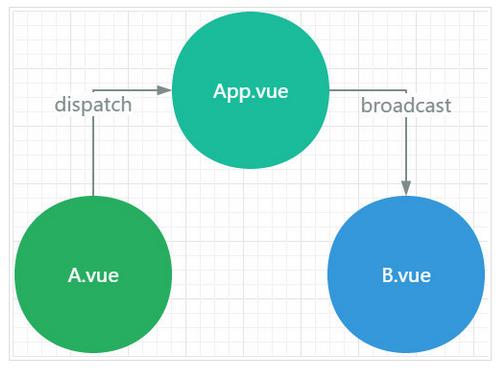
- A组件说: "报告老大, 能否帮我托个信给小弟B" => dispatch一个事件给App
- App老大说: "包在我身上, 它需要监听A组件的dispatch的时间, 同时需要broadcast一个事件给B组件"
- B小弟说: "信息已收到", 它需要on监听App组件分发的事件
这只是一条通讯路径, 如果父组件下有多个子组件, 子组件之间通讯的路径就会变的很繁琐, 父组件需要监听大量的事件, 还需要负责分发给不同的子组件, 很显然这并不是我们想要的组件化的开发体验.
三.如何引入Vuex?
- 下载
vuex:npm install vuex --save - 在
main.js添加:
import Vuex from \'vuex\' Vue.use( Vuex ); const store = new Vuex.Store({ //待添加 }) new Vue({ el: \'#app\', store, render: h => h(App) })
四. Vuex的核心概念?
vue-cli初始化了一个demo, 准备以代码的形式来说明Vuex的核心概念.这个demo分别有两个组件ProductListOne.vue和ProductListTwo.vue, 在App.vue的datat中保存着共有的商品列表, 代码和初始化的效果如下图所示: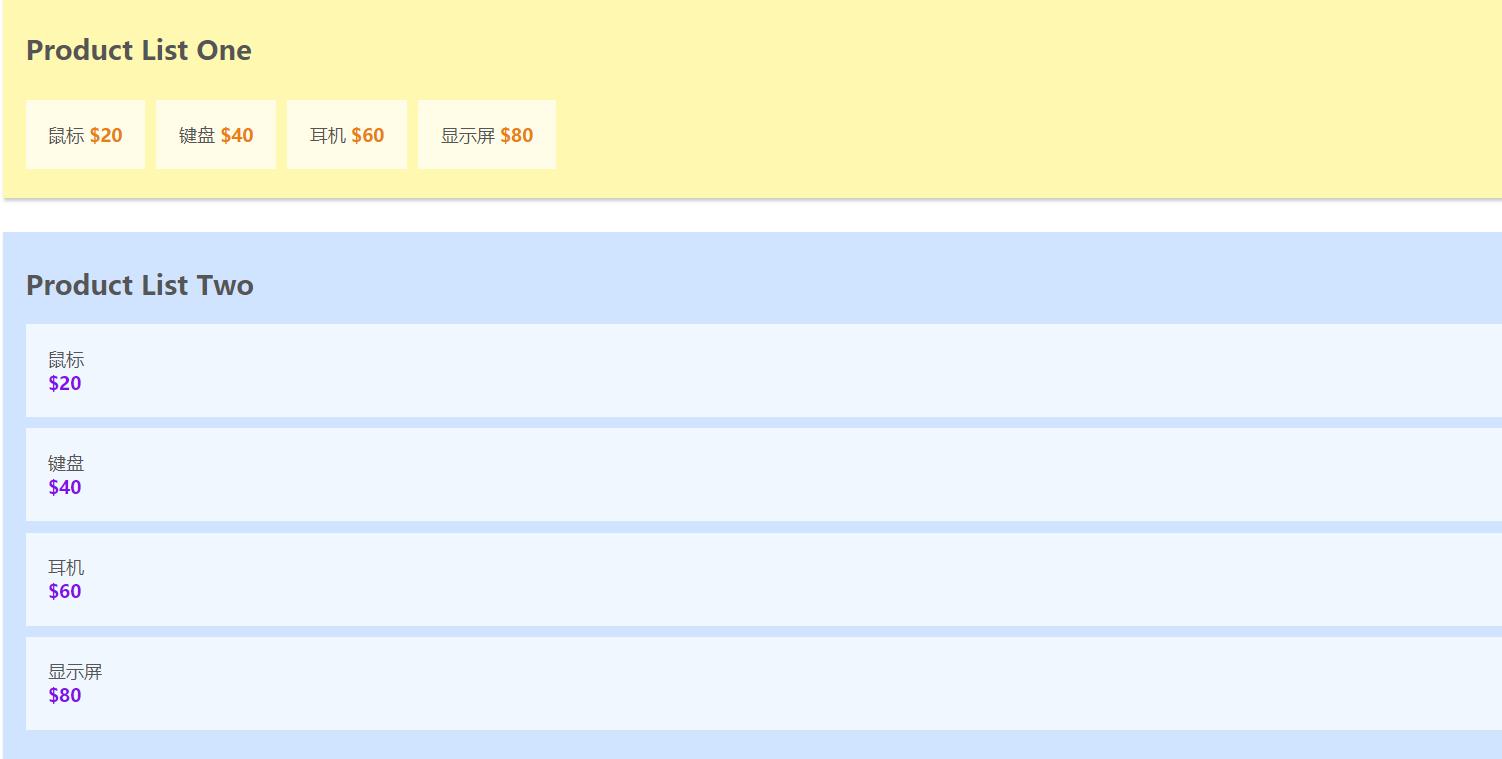
//App.vue中的初始化代码 <template> <div id="app"> <product-list-one v-bind:products="products"></product-list-one> <product-list-two v-bind:products="products"></product-list-two> </div> </template> <script> import ProductListOne from \'./components/ProductListOne.vue\' import ProductListTwo from \'./components/ProductListTwo.vue\' export default { name: \'app\', components: { \'product-list-one\': ProductListOne, \'product-list-two\': ProductListTwo }, data () { return { products: [ {name: \'鼠标\', price: 20}, {name: \'键盘\', price: 40}, {name: \'耳机\', price: 60}, {name: \'显示屏\', price: 80} ] } } } </script> <style> body{ font-family: Ubuntu; color: #555; } </style>
//ProductListOne.vue <template> <div id="product-list-one"> <h2>Product List One</h2> <ul> <li v-for="product in products"> <span class="name">{{ product.name }}</span> <span class="price">${{ product.price }}</span> </li> </ul> </div> </template> <script> export default { props: [\'products\'], data () { return { } } } </script> <style scoped> #product-list-one{ background: #FFF8B1; box-shadow: 1px 2px 3px rgba(0,0,0,0.2); margin-bottom: 30px; padding: 10px 20px; } #product-list-one ul{ padding: 0; } #product-list-one li{ display: inline-block; margin-right: 10px; margin-top: 10px; padding: 20px; background: rgba(255,255,255,0.7); } .price{ font-weight: bold; color: #E8800C; } </style>
//ProductListTwo.vue <template> <div id="product-list-two"> <h2>Product List Two</h2> <ul> <li v-for="product in products"> <span class="name">{{ product.name }}</span> <span class="price">${{ product.price }}</span> </li> </ul> </div> </template> <script> export default { props: [\'products\'], data () { return { } } } </script> <style scoped> #product-list-two{ background: #D1E4FF; box-shadow: 1px 2px 3px rgba(0,0,0,0.2); margin-bottom: 30px; padding: 10px 20px; } #product-list-two ul{ padding: 0; list-style-type: none; } #product-list-two li{ margin-right: 10px; margin-top: 10px; padding: 20px; background: rgba(255,255,255,0.7); } .price{ font-weight: bold; color: #860CE8; display: block; } </style>
核心概念1: State
state就是Vuex中的公共的状态, 我是将state看作是所有组件的data, 用于保存所有组件的公共数据.
- 此时我们就可以把
App.vue中的两个组件共同使用的data抽离出来, 放到state中,代码如下:
//main.js import Vue from \'vue\' import App from \'./App.vue\' import Vuex from \'vuex\' Vue.use( Vuex ) const store = new Vuex.Store({ state:{ products: [ {name: \'鼠标\', price: 20}, {name: \'键盘\', price: 40}, {name: \'耳机\', price: 60}, {name: \'显示屏\', price: 80} ] } }) new Vue({ el: \'#app\', store, render: h => h(App) })
- 此时,
ProductListOne.vue和ProductListTwo.vue也需要做相应的更改
//ProductListOne.vue export default { data () { return { products : this.$store.state.products //获取store中state的数据 } } }
//ProductListTwo.vue export default { data () { return { products: this.$store.state.products //获取store中state的数据 } } }
此时的页面如下图所示, 可以看到, 将公共数据抽离出来后, 页面没有发生变化.
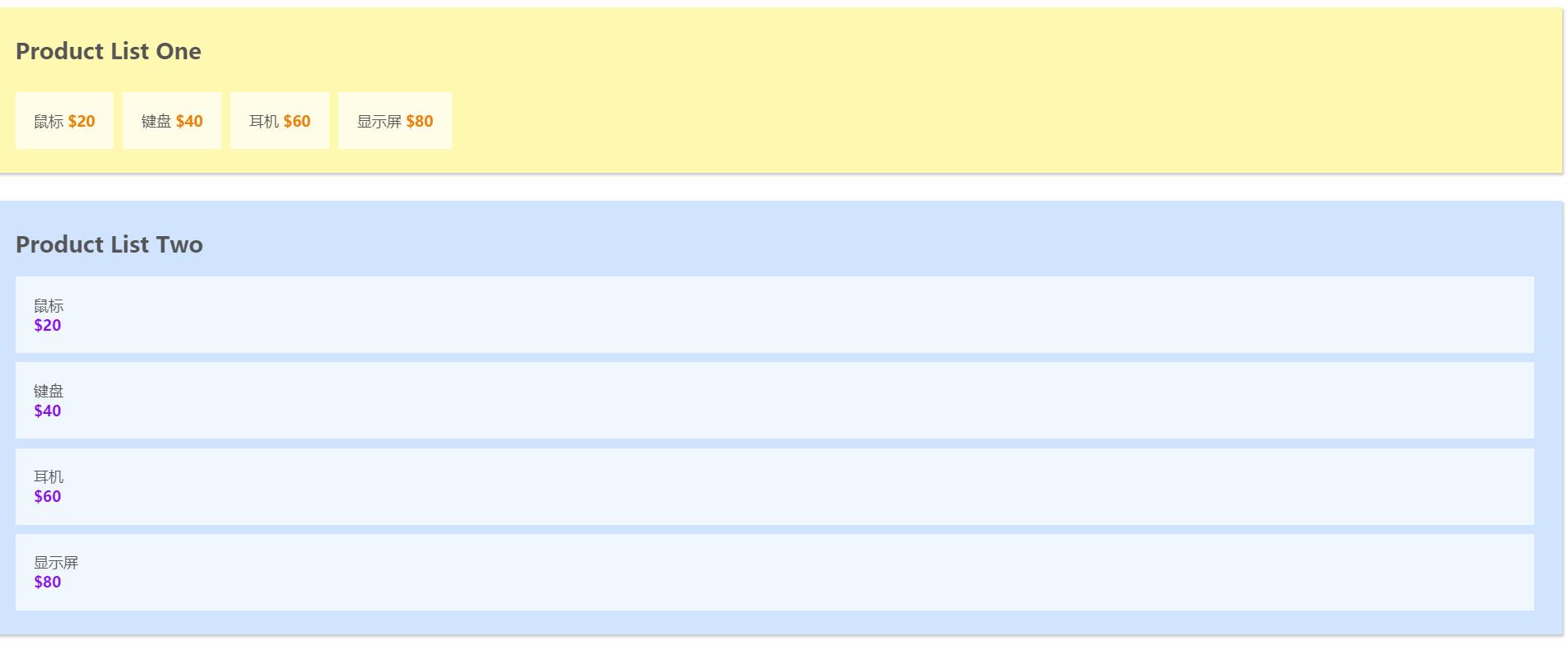
核心概念2: Getters
我将getters属性理解为所有组件的computed属性, 也就是计算属性. vuex的官方文档也是说到可以将getter理解为store的计算属性, getters的返回值会根据它的依赖被缓存起来,且只有当它的依赖值发生了改变才会被重新计算。
- 此时,我们可以在
main.js中添加一个getters属性, 其中的saleProducts对象将state中的价格减少一半(除以2)
//main.js const store = new Vuex.Store({ state:{ products: [ {name: \'鼠标\', price: 20}, {name: \'键盘\', price: 40}, {name: \'耳机\', price: 60}, {name: \'显示屏\', price: 80} ] }, getters:{ //添加getters saleProducts: (state) => { let saleProducts = state.products.map( product => { return { name: product.name, price: product.price / 2 } }) return saleProducts; } } })
- 将
productListOne.vue中的products的值更换为this.$store.getters.saleProducts
export default { data () { return { products : this.$store.getters.saleProducts } } }
- 现在的页面中,Product List One中的每项商品的价格都减少了一半

核心概念3: Mutations
我将mutaions理解为store中的methods, mutations对象中保存着更改数据的回调函数,该函数名官方规定叫type, 第一个参数是state, 第二参数是payload, 也就是自定义的参数.
- 下面,我们在
main.js中添加mutations属性,其中minusPrice这个回调函数用于将商品的价格减少payload这么多, 代码如下:
//main.js const store = new Vuex.Store({ state:{ products: [ {name: \'鼠标\', price: 20}, {name: \'键盘\', price: 40}, {name: \'耳机\', price: 60}, {name: \'显示屏\', price: 80} ] }, getters:{ saleProducts: (state) => { let saleProducts = state.products.map( product => { return { name: product.name, price: product.price / 2 } }) return saleProducts; } }, mutations:{ //添加mutations minusPrice (state, payload ) { let newPrice = state.products.forEach( product => { product.price -= payload }) } } })
- 在
ProductListTwo.vue中添加一个按钮,为其添加一个点击事件, 给点击事件触发minusPrice方法
//ProductListTwo.vue <template> <div id="product-list-two"> <h2>Product List Two</h2> <ul> <li v-for="product in products"> <span class="name">{{ product.name }}</span> <span class="price">${{ product.price }}</span> </li> <button @click="minusPrice">减少价格</button> //添加按钮 </ul> </div> </template>
- 在
ProductListTwo.vue中注册minusPrice方法, 在该方法中commitmutations中的minusPrice这个回调函数
注意:调用mutaions中回调函数, 只能使用store.commit(type, payload)
//ProductListTwo.vue export default { data () { return { products: this.$store.state.products } }, methods: { minusPrice() { this.$store.commit(\'minusPrice\', 2); //提交`minusPrice,payload为2 } } }
添加按钮, 可以发现, Product List Two中的价格减少了2, 当然你可以自定义payload,以此自定义减少对应的价格.
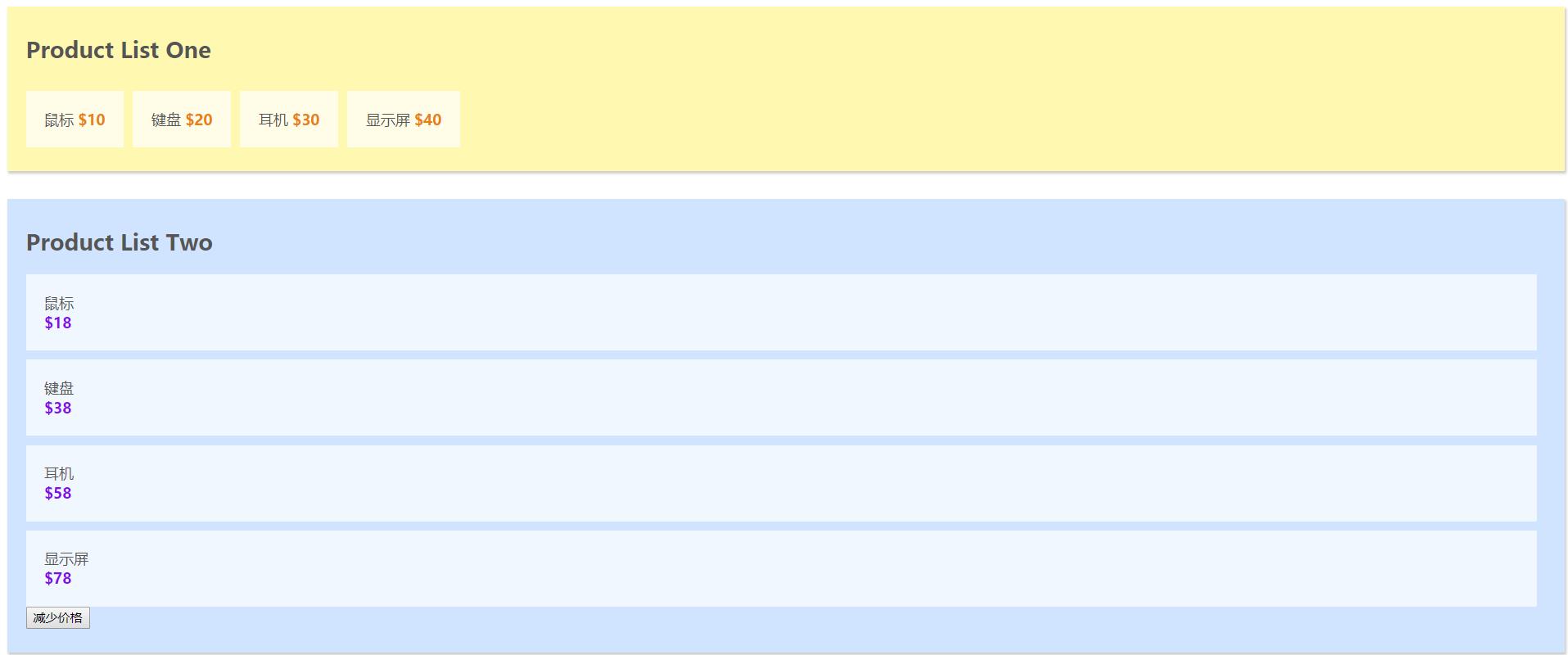
(Product List One中的价格没有发生变化, 是因为getters将价格进行了缓存)
核心概念4: Actions
actions 类似于 mutations,不同在于:
-
actions提交的是mutations而不是直接变更状态 -
actions中可以包含异步操作,mutations中绝对不允许出现异步 -
actions中的回调函数的第一个参数是context, 是一个与store实例具有相同属性和方法的对象 -
此时,我们在
store中添加actions属性, 其中minusPriceAsync采用setTimeout来模拟异步操作,延迟2s执行 该方法用于异步改变我们刚才在mutaions中定义的minusPrice
//main.js const store = new Vuex.Store({ state:{ products: [ {name: \'鼠标\', price: 20}, {name: \'键盘\', price: 40}, {name: \'耳机\', price: 60}, {name: \'显示屏\', price: 80} ] }, getters:{ saleProducts: (state) => { let saleProducts = state.products.map( product => { return { name: product.name, price: product.price / 2 } }) return saleProducts; } }, mutations:{ minusPrice (state, payload ) { let newPrice = state.products.forEach( product => { product.price -= payload }) } }, actions:{ //添加actions minusPriceAsync( context, payload ) { setTimeout( () => { context.commit( \'minusPrice\', payload ); //context提交 }, 2000) } } })
- 在
ProductListTwo.vue中添加一个按钮,为其添加一个点击事件, 给点击事件触发minusPriceAsync方法
<template>
<div id="product-list-two">
<h2>Product List Two</h2>
<ul>
<li v-for="product in products">
<span class="name">{{ product.name }}</span>
<span class="price">${{ product.price }}</span>
</li>
<button @click="minusPrice">减少价格</button>
<button @click="minusPriceAsync">异步减少价格</button> //添加按钮
</ul>
</div>
</template>
- 在
ProductListTwo.vue中注册minusPriceAsync方法, 在该方法中dispatchactions中的minusPriceAsync这个回调函数
export default { data () { return { products: this.$store.state.products } }, methods: { minusPrice() { this.$store.commit(\'minusPrice\', 2); }, minusPriceAsync() { this.$store.dispatch(\'minusPriceAsync\', 5); //分发actions中的minusPriceAsync这个异步函数 } } }
添加按钮, 可以发现, Product List Two中的价格延迟2s后减少了5
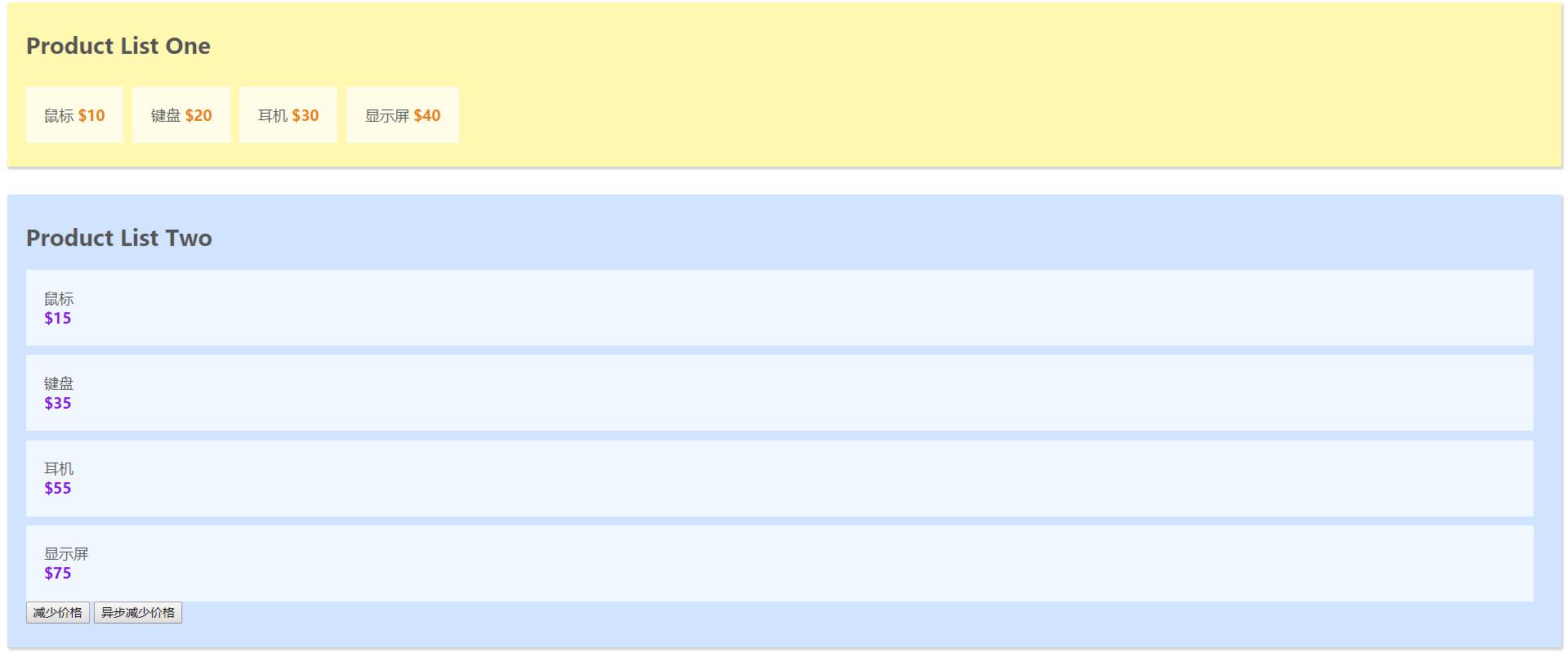
核心概念5: Modules
由于使用单一状态树,应用的所有状态会集中到一个比较大的对象。当应用变得非常复杂时,store 对象就有可能变得相当臃肿。为了解决以上问题,Vuex 允许我们将 store 分割成模块(module)。每个模块拥有自己的 state、mutation、action、getter、甚至是嵌套子模块——从上至下进行同样方式的分割
const moduleA = { state: { ... }, mutations: { ... }, actions: { ... }, getters: { ... } } const moduleB = { state: { ... }, mutations: { ... }, actions: { ... } } const store = new Vuex.Store({ modules: { a: moduleA, b: moduleB } }) store.state.a // -> moduleA 的状态 store.state.b // -> moduleB 的状态
以上是关于Vue.js——快速入门Vuex的主要内容,如果未能解决你的问题,请参考以下文章